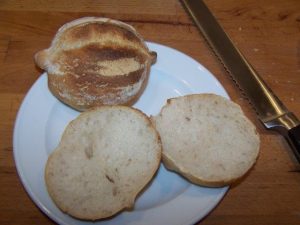
The Ceriola I baked last week were very good. A nice crispy crust and a airy crump, looking as nice as rolls from the bakery. The best rolls I ever bake!
But one single person testing the rolls declared, that the rolls are fine, but the rolls from the bakery are more fluffy. Ok, that arouse my ambition. The recipe itself was fine, I was sure about this. But maybe the methode was wrong? I recalled a post Steve from Bread cetera published some weeks ago. In the Post “More Musings on Mixing” he showed an intressing technique to prepare dough.
Like him, I used the whisking attachment to mix the batter consisting of the sourdough, the yeast, all of the water and a little amount of flour, untill the mixture becomed aerated. Now I changed to the dough hook to mix shortly the rest of the flour with batter. After a resting periode for autolysis, the dough was kneaded untill the gluten developed. That happend really fast, one minute after kneading the dough started to become smooth and after another four minutes the gluten was well developed.
I formed and proofed the rolls like the last time. Because in my oven is just room for nine rolls ad once when I use my baking stone, I put the rest of the rolls in the fridge so they had the same nice ovenspring as the first batch.
When cooling after baking the crust make some nice cracking sounds. And the crust was as crispy as the cracking sounds promise and the crump was much more fluffy then my first batch I baked last week. As fluffy as a roll from the bakery, but without improving chemistry 😀
Ceriola (new methode)
yields 26 rolls
- 400g ripe sourdough (100% Hydration)
- 1000g flour(Type 550)
- 20 g yeast
- 2 teaspoons barley malt
- 600g water
- 2 teaspoons citron juice
- 4 spoons oil
- 24g salt
Use the whisking attachment to mix the batter consisting of the sourdough, the yeast, all of the water and 150g flour, untill the mixture becomed aerated. Now chang to the dough hook to mix shortly the rest of the flour with batter. After a resting periode of 30 min for autolysis, knead the dough for 5 min untill the gluten developed.
Rest for 30 min at a warm place. Put the dough at your working surface and weigh pieces of ca 75g – 80g. Form to a ball. Now use the edge of your hand to press in the middle of the bowl. Fold it together and roll the ends, giving the roll two pointed Ends.Let rise with the seamside down for 60 min. Preheat the oven with the bakingstone at 250°C during this time.
After rising, turn the rolls, so the side on which they were lying during rising is now the upper part. Bake the rolls on the hot stone with steam for 25 min.
This is my post for Susans weekly YeastSpotting.
Deutsch



Im Rezept wird der Zitronensaft nicht erwähnt – wofür?
@Manuel: Ich habe es im Rezepttext ergänzt. Er dient als Vitamin C-Quelle und somit zur Stärkung des Glutennetzwerkes.
Ich würde die Brötchen gerne backen. Benötige ich für den Teig Roggen- oder Weizensauerteig? Ich habe noch einen angesetzten Roggensauer. Muss ich ihn erst füttern?
Liebe Grüße
Monika
@Monika: Ja, der Sauerteig muss gefüttert werden (200g Mehl Type 550 und 200g Wasser, 20g Sauerteig (egal ob Roggen oder Weizen)) und sollte bei 25°C etwa 12-16 Stunden (je nach Triebkraft) reifen lassen.
Danke für die schnelle Antwort. Ich habe doch noch eine Frage. Ist das Gerstenmalz aktiv oder inaktiv?
LG Monika
@Monika: Das Malz ist inaktiv!
Pingback: Hefe und mehr » Blog Archive » Sacaduros – BBD #27
Nochmal danke für deine telefonische Unterstützung!
Um Mitternacht war dann auch die dritte und letzte Portion Brötchen fertig. Sie sind wunderschön geworden und schmecken sehr, sehr lecker.
Ich bin begeistert von diesem Rezept.
Pingback: Brötchen mit Poolish | Hefe und mehr
Looking good — so cool that you got these results with Steve’s technique!
Nick,
The term “Spritzer” is my favorite then, because in german its “Blumenspritze”. The idea of using a steam cleaner to introduce steam to the oven is good, too.
Stefanie,
Originally, I thought you were completely wrong…
Flacon: “A small, often decorative bottle with a tight-fitting stopper or cap.”
I have never heard that word before, but it appears to be OK. What we would normally say would be: “A sprayer” or colloquially, but more accurate: “a SPRITZER.,” from the verb “Spritz” meaning “A quick squirt or spray.”
I used to use this same method but have gotten better results from a very cheap home steamer, a Scunci Steamer
Das muss ich ausprobieren 🙂
Hi Nick,
I use a spraying flacon (hope thats the right word), you normaly use to spray water at plants.
I spray at the walls of the oven after I put the bread on the hot stone. That gives a nice steam inside of the oven. I have this trick from the bread-baking forum from chefkoch.de.
YUM, I want to make a cheese and jam sandwich out of those rolls.
How do you introduce steam into your oven?
I’m glad you were able to get good results using the double flour addition technique. I, too, find that the gluten develops quicker using this technique.